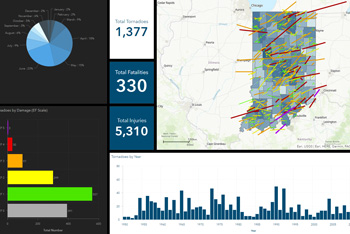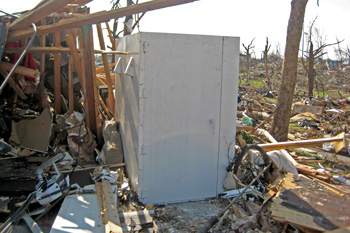Tornadoes
- Get Prepared
- Nature Safety
- Current: Tornadoes
More than 1,500 tornadoes have been verified in Indiana since 1950, causing more than 5,000 injuries and 300 fatalities. In 2024, 57 tornadoes were recorded in the state.
Tornadoes are violent, rotating cylinders that can have wind speeds in excess of 300 mph, be more than a mile wide and cover approximately 50 miles during destruction. Because tornadoes are one of the more common natural-disaster risks the state faces, it is imperative Hoosiers are prepared before one occurs.
Tornado Safety Tips
Quick Tips
- Identify safe places to shelter. For optimal protection, choose basements, storm cellars and inner rooms away from doors, windows and outer walls.
- If you live in a mobile or manufactured home, identify an alternative shelter such as a single-family home, designated tornado shelter or building built with reinforced concrete. Also, find the best route to this shelter and practice how long it takes to get there.
- During tornado warnings, move to the lowest level of a sturdy building. It is best to go to a basement, safe room or storm cellar. If unavailable, use an interior room or hallway without windows.
- Stay out of damaged buildings until they have been inspected and cleared by a building official.
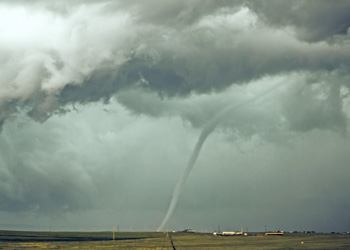
Watch vs. Warning
- Tornado Watch: Conditions for a tornado are favorable. Stay alert about approaching storms.
- Tornado Warning: A tornado has been reported or has been detected by the National Weather Service's weather radar. Seek shelter immediately.
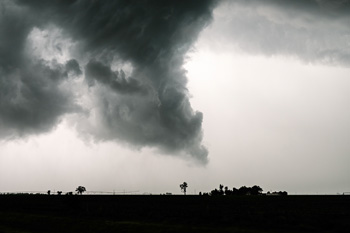
Before a Tornado
Meteorologists can predict these violent forces of nature, but even with warning tornadoes can still be devastating. The best protection against them is by being prepared.
- Purchase and configure an all-hazard weather radio, and have more than one way to get weather alerts.
- Make sure preparedness kits are portable for easy transport if evacuation is necessary. Preparedness kits should be tailored to household needs.
- Identify safe places to shelter. For optimal protection, choose basements, storm cellars and inner rooms away from doors, windows and outer walls.
- If you live in a mobile or manufactured home, identify an alternative shelter location such as a single-family home, designated tornado shelter or building built with reinforced concrete. Also, determine the best evacuation route to this shelter and practice how long it takes to get there. When severe weather is in the forecast, check ahead that these locations are still available to you.
- Review and practice your severe weather plans and those created by employers and local schools.
- Tornadoes can occur at any time, and often happen at night. Conduct household tornado drills at various times during the day so everyone is prepared for the possibilities.
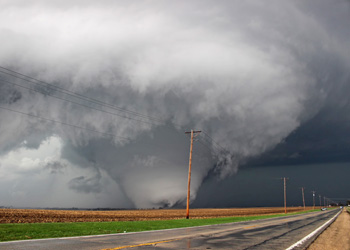
During a Tornado
- Move to the lowest level of a sturdy building. It is best to go to a basement, safe room or storm cellar. If unavailable, use an interior room or hallway where there are no windows. Cover your head and neck with your arms. Blankets, pillows and furniture can provide additional protection.
- If in a vehicle, the best choice is to get out and take shelter in a strong building. If no building is available, stay in the vehicle, keep your seatbelt on, lower your head below the window and cover your head and neck with your arms and a blanket.
- Do not take shelter at bridges. Strong winds can cause damage to the structure and cause it to collapse, you are not protected from flying debris and vehicles stopped there can block roadways and prevent others from reaching real shelter.
- Mobile or manufactured homes are not safe during a tornado, even if they are tied down. You are more than 15–20 times more likely to die in a mobile home than a permanent structure. When a tornado watch is issued, residents of these homes should leave immediately and find a shelter with a strong foundation instead.
- If possible, bring pets indoors and secure them to prevent escaping.
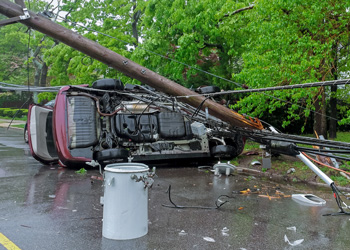
After a Tornado
Tornadoes have the ability to destroy buildings, uproot trees and leave behind a large amount of dangerous debris. These tips can help you and others stay safe immediately following a tornado:
- Stay out of damaged buildings until they have been inspected and cleared by a building official.
- Help others, especially those who might be trapped or injured.
- Reserve phone calls for emergencies. Phone wires may be damaged and have limited access.
- Stay far away from downed power lines.
- Be aware of possible gas leaks, so do not use matches or lighters.
- Monitor radio, television, website or social media outlets for further instructions from local officials.
Resources
Websites
- Tornado Safety
American Red Cross - Tornadoes
Ready.gov
Safe Rooms
In an average year, 800 tornadoes are reported nationwide, resulting in 80 deaths and more than 1,500 injuries. Protecting Hoosiers since 2015, the IDHS Safe Room Program has helped residents and communities statewide install hardened structures specifically designed to provide "near-absolute protection" in extreme weather events, like tornadoes.
Safe rooms provide a shield of protection, and studies demonstrate that they can survive winds as high as 250 miles per hour. Built above or below ground level, safe rooms are customizable. They can be small enough for a family to seek shelter or large enough for dozens of school students and staff to hunker down.
IDHS coordinates with the Federal Emergency Management Agency (FEMA) on the grant program to provide partial reimbursement for safe room projects. For more information on community and residential safe rooms, visit the Mitigation page.

